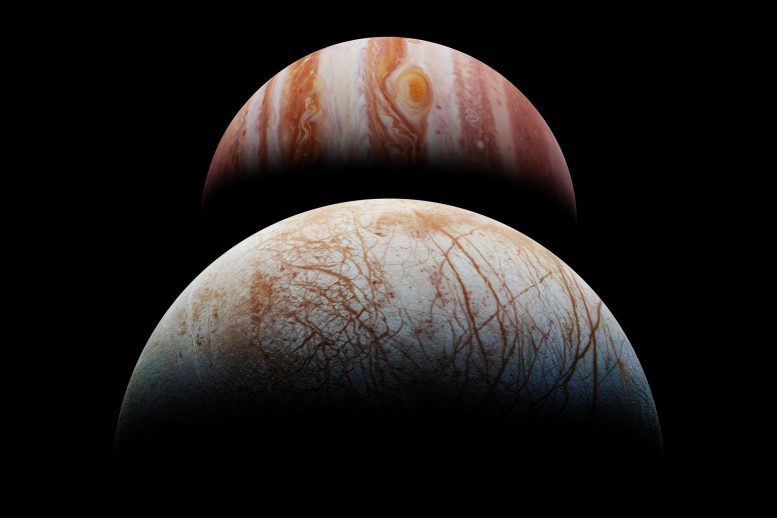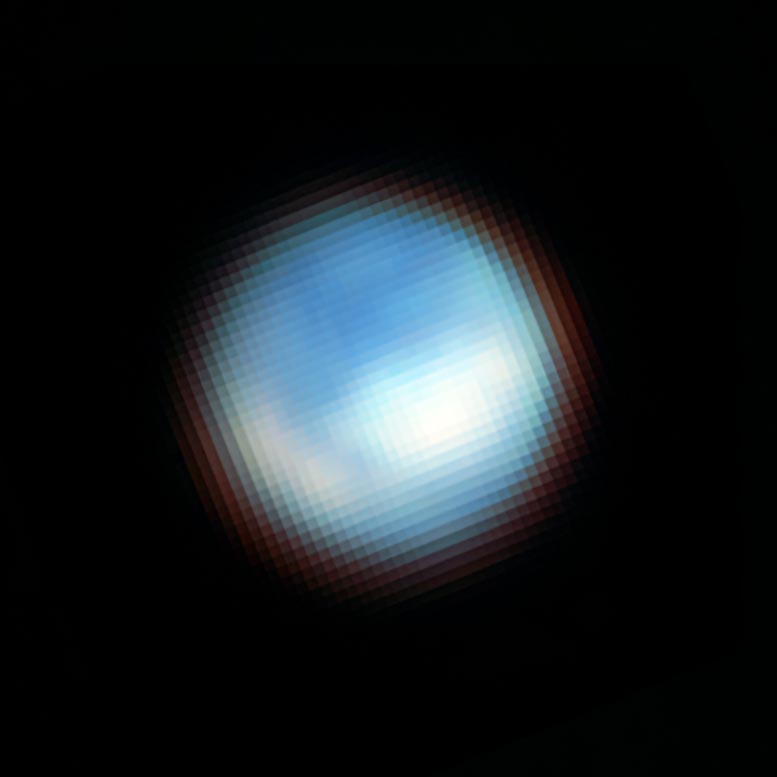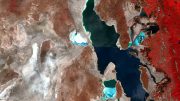
Observations from the James Webb Space Telescope have led two independent studies to suggest that the CO2 ice on Jupiter’s moon, Europa, originates from its subsurface ocean. These findings offer new insights into the composition of Europa’s internal ocean, which is considered a prime target in the search for extraterrestrial life.
Two studies indicate that CO2 on Europa’s surface originated from within the moon’s internal ocean.
Recent Webb Space Telescope observations of Europa suggest that the moon’s CO2 ice originates from its subsurface ocean, underscoring the presence of abundant carbon in this potential hub for extraterrestrial life.
Origin of CO2 on Jupiter’s Moon Europa
A pair of independent studies, using recent James Webb Space Telescope (JWST) observations of carbon dioxide (CO2) ice on Jupiter’s moon Europa, indicate the CO2 originates from a source within the icy body’s subsurface ocean. The findings from both research groups provide new insights into the poorly known composition of Europa’s internal ocean.
Beneath a crust of solid water ice, Jupiter’s moon Europa is thought to have a subsurface ocean of salty liquid water. Because of this, Europa is a prime target in the search for life elsewhere in the Solar System. Assessing this deep ocean’s potential habitability depends on its chemistry, including the abundance of biologically essential elements like carbon.
Previous research has identified the presence of solid CO2 ice on Europa’s surface, but it has not been possible to establish whether the CO2 originated from the subsurface ocean, was delivered to the moon’s surface by meteorite impacts, or was produced on the surface through interactions with Jupiter’s magnetosphere. Determining the source of the CO2 could constrain the chemistry of Europa’s internal ocean.

NIRCam (the Near Infrared Camera) on NASA’s James Webb Space Telescope captured this picture of the surface of Jupiter’s moon Europa. Webb identified carbon dioxide on the icy surface of Europa that likely originated in the moon’s subsurface ocean. This discovery has important implications for the potential habitability of Europa’s ocean. The moon appears mostly blue because it is brighter at shorter infrared wavelengths. The white features correspond with the chaos terrain Powys Regio (left) and Tara Regio (center and right), which show enhanced carbon dioxide ice on the surface. Credit: NASA, ESA, CSA, Gerónimo Villanueva (NASA-GSFC), Samantha K Trumbo (Cornell University), Gerónimo Villanueva (NASA-GSFC), Alyssa Pagan (STScI)
Analysis of CO2 Distribution on Europa
In two separate studies, researchers analyze near-infrared spectroscopy of CO2 on Europa’s surface, obtained with JWST.
In one study, Samantha Trumbo and Michael Brown used the JWST data to map the distribution of CO2 on Europa and found the highest abundance of CO2 is located in Tara Regio – a ~1,800 square kilometer region dominated by “chaos terrain,” geologically disrupted resurfaced materials.
According to researchers, the amount of CO2 identified within this recently resurfaced region – some of the youngest terrain on Europa’s surface – indicates that it was derived from an internal source of carbon. This implies that the CO2 formed within Europa’s subsurface ocean and was brought to the surface on a geologically recent timescale.
However, the authors say that the formation of CO2 on the surface from ocean-derived organics or carbonates cannot be entirely ruled out. In either interpretation, the subsurface ocean contains carbon.

This graphic shows a map of Europa’s surface with NIRCam (Near Infrared Camera) on NASA’s James Webb Space Telescope in the first panel and compositional maps derived from Webb’s NIRSpec/IFU (Near Infrared Spectrograph’s Integral Field Unit) data in the following three panels. In the compositional maps, the white pixels correspond to carbon dioxide in the large-scale region of disrupted chaos terrain known as Tara Regio (center and right), with additional concentrations within portions of the chaos region Powys Regio (left). The second and third panels show evidence of crystalline carbon dioxide, while the fourth panel indicates a complexed and amorphous form of carbon dioxide. Credit: NASA, ESA, CSA, Gerónimo Villanueva (NASA-GSFC), Samantha K Trumbo (Cornell University), Gerónimo Villanueva (NASA-GSFC), Alyssa Pagan (STScI)
Concurrent Findings from Another Study
In an independent study of the same JWST data, Geronimo Villanueva and colleagues found that the CO2 on Europa’s surface is mixed with other compounds. The research team also found that the CO2 is concentrated in Tara Regio and interpreted that as demonstrating that the carbon on the moon’s surface was sourced from within.
The authors measured the ice’s 12C/13C isotopic ratio, but could not distinguish between an abiotic or biogenic source. Moreover, the research team searched for plumes of volatile material breaching the moon’s icy crust. Although previous studies have reported evidence of these features, the authors did not detect any plume activity during the JWST observations.
They argue that plume activity on Europa could be infrequent, or sometimes does not contain the volatile gasses they included in their search. The results in both studies complement each other and reinforce the conclusion that Europa’s subsurface ocean contains abundant carbon.
For more on this discovery, see NASA’s Webb Finds Carbon Source on Surface of Europa.
References:
“The distribution of CO2 on Europa indicates an internal source of carbon” by Samantha K. Trumbo and Michael E. Brown, 21 September 2023, Science.
DOI: 10.1126/science.adg4155
“Endogenous CO2 ice mixture on the surface of Europa and no detection of plume activity” by G. L. Villanueva, H. B. Hammel, S. N. Milam, S. Faggi, V. Kofman, L. Roth, K. P. Hand, L. Paganini, J. Stansberry, J. Spencer, S. Protopapa, G. Strazzulla, G. Cruz-Mermy, C. R. Glein, R. Cartwright and G. Liuzzi, 21 September 2023, Science.
DOI: 10.1126/science.adg4270









Be the first to comment on "Potential Hub for Extraterrestrial Life: Webb Observations of CO2 on Jupiter’s Moon Europa"